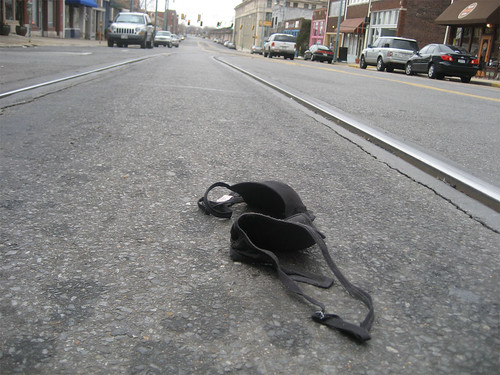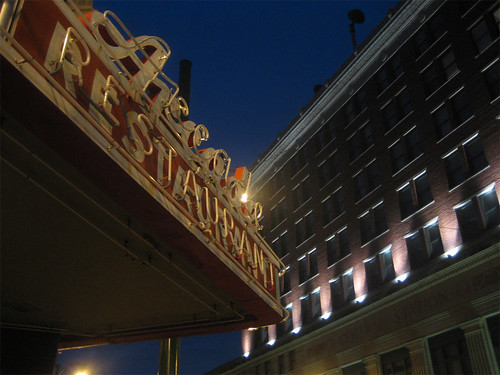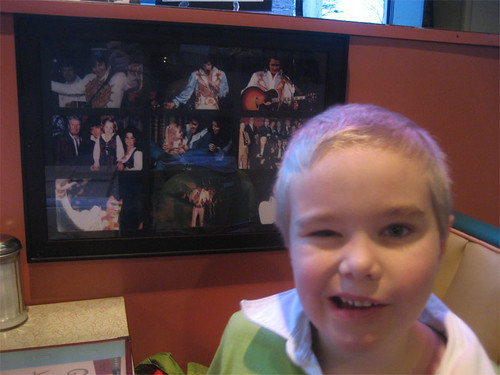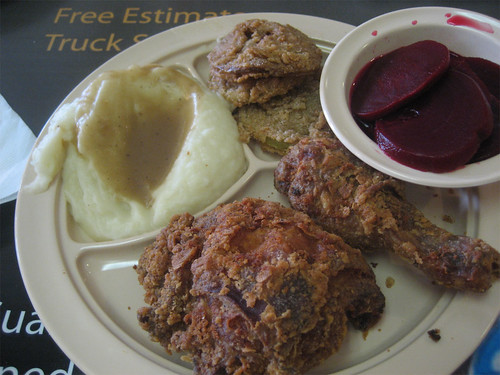
One of the things about being a 21st century foodie is that far distant cities start seeming like just another place to grab a bite. A century or so ago, San Francisco was an arduous sea journey around the end of the world; nobody went there from Chicago, they went there instead of Chicago and never came back. Now our rising chefs do a stint on their resumes there, and even if direct flights haven’t made us personally familiar with name spots like Slanted Door or Gary Danko, food TV lets us act like we have.
Yet a place like Memphis and the delta blues country beyond it, which is tied historically and geographically to Chicago in ways that San Francisco will never be, still seems distant and vaguely out of time by comparison– not part of the circuit of modern capitols of Trendsylvania. Just eight hours away by train, Memphis was for much of the 20th century the gateway to the industrial north, the Ellis Island for sharecroppers seeking factory jobs in Chicago and Detroit– and gigs in the clubs where electric blues was being born. It’s the matching bookend of much of our cultural history, yet Chicagoans rarely think of it as the close kin it is.
Flying to Memphis is for FedEx packages; my family and I decided to retrace the great northern migration backwards, and booked a sleeper on the City of New Orleans, which worked out perfectly since we have exactly the number and height of family members to fit one of Amtrak’s family bedrooms (two long and two short bunks). As my sons settled into their beds, I tried to set the scene for the older one, at least, by explaining concepts such as sharecropping, race music, and why Elvis made a lot more money off songs black people wrote than Big Mama Thornton ever did. (I skipped why Colonel Parker did, too.)
And I explained that we would be living on barbecue and meat and threes for the next week. One son licked his lips. The other said, “I only eat French fries.”
* * *

Seven hours later, half rested and half shaken apart by the rickety tracks, having passed through more beautifully bleak small town winter landscapes than Andrew Wyeth could count, we pulled in darkness into Memphis’ Central Station, piling our bags in the waiting room to tick off the 70 minutes until The Arcade opened.
The Arcade is a pink-and-blue 50s dinette opposite the train station and at the end of the trolley line, so Hollywood-perfect that a plaque out front names all the movies it’s been in (Mystery Train, The Firm, Walk the Line…). Almost too cute to be true, it survived the long period when the area south of Beale Street was derelict and largely no-go for white Memphians (not least because of the shooting of Martin Luther King a block north of there), and now anchors a district of even cuter folk art galleries and coffee houses.

The Arcade may have been saved during the urban neglect years by association with its most famous customer, Elvis, who claimed the back booth for his Memphis mafia. Today you too can sit where the King rested his sequined rump… especially if you’re the only people in Memphis actually up and out that early, as we were. Breakfast was pretty classic stuff– biscuits and gravy, sweet potato pancakes, hash browns that were no doubt better a half hour later when the place had been running for a bit. It was decent enough if not life-altering, but the combination of setting, stop on the Elvis trail, and Southern hospitality so warm and cozy you could crawl up in it and go to sleep made for a charming welcome to Memphis… or at least a charming welcome to the theme park version of it.
In Chicago the line between ersatz and genuinely old school is pretty clear; nobody really thinks Ed Debevic’s has been there since the 50s, or that Superdawg hasn’t. In Memphis, though, as in New Orleans, Austin and other good-time capitols of the South, people and places seem to delight in living up to the broadest possible cartoon of themselves. When a table full of litigators rolls up their sleeves over a mess o’ fried catfish in a place decorated with “funny” signs and shouts how they’re gonna whomp the other side’s bee-hind, you wonder if John Grisham was describing what he’d seen, or if they’re being what John Grisham described. (Yes and yes, I suspect.)
Still, you can see why people choose to live in a self-consciously flamboyant South when they can get away with it. After spending the morning at the Memphis Zoo (who knew Memphis had pandas?), we hit a meat-and-threes place for lunch called The Cupboard, picked off Jane and Michael Stern’s Roadfood.com. It’s located in a former Shoney’s, and anything that makes a Shoney’s former is points ahead with me.

But the vaguely institutional air, the dull sports memorabilia decor, our table (which either advertised a towing service, or recycled some Formica from one), and the hit-and-miss food– fried green tomatoes and beets good, fried chicken and collard greens acceptable, steamed squash sent over from the old folks’ home across the street– was drab enough to be in any strip mall, anywhere in America. (On the other hand, the younger son loved his two orders of tater tots.) If that was the alternative, it was easy to see why lots of people choose to live in, and up to, Memphis’ infinitely livelier caricature of itself.


 If you like this post and would like to receive updates from this blog, please subscribe our feed.
If you like this post and would like to receive updates from this blog, please subscribe our feed.




